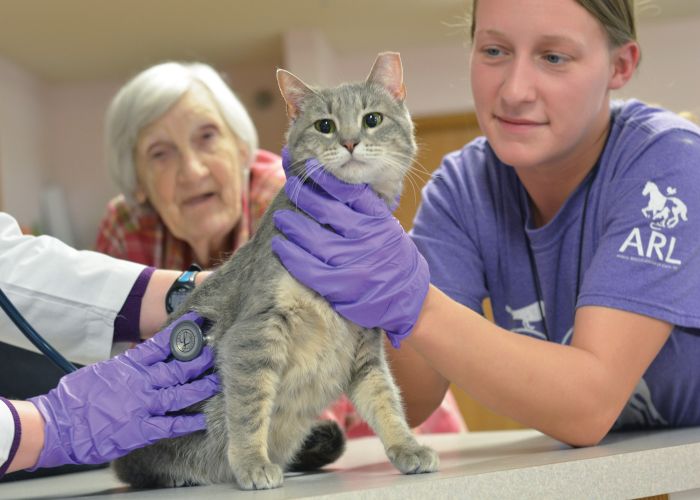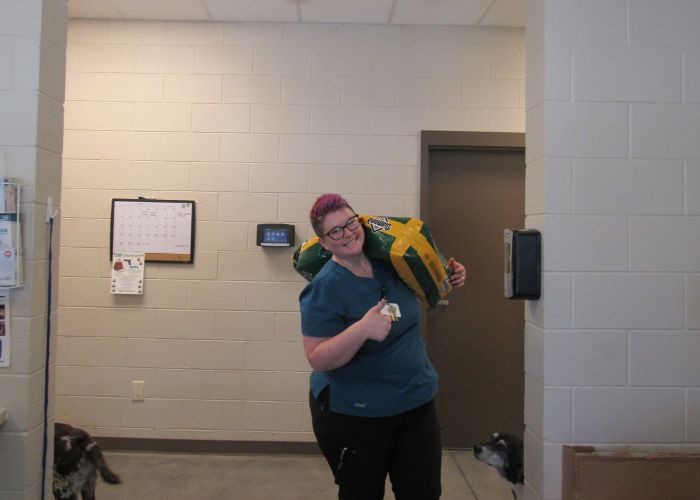Making meetings matter
The surprising impact of terrible meetings, and how to run great ones

The air in your shelter’s cramped conference room is stagnant. Bodies shift, some hunch over phones, a pair huddle over a stack of veterinary records. You look at the clock. The meeting should have ended 20 minutes ago. Finally, your boss moves to adjourn.
“One more thing!” a voice calls out. Your teeth clench as you think of the volunteer orientation you have to lead in 10 minutes.
Meetings. For many, it might as well be a four-letter word. But by following a few simple guidelines, you can transform frustration-fests into productive gatherings that employees actually look forward to.
The high price of bad meetings
Bad meetings are more than just an annoyance. In addition to wasting time, lousy meetings affect employee morale, says Steven Rogelberg.
As professor of organizational psychology, business and management at the University of North Carolina at Charlotte and author of The Surprising Science of Meetings: How You Can Lead Your Team to Peak Performance, Rogelberg has made a serious study of meetings. Additionally, as part of the Shelter Employee Engagement & Development Survey at UNCC, he’s conducted engagement surveys with employees in more than 1,000 animal shelters.
“In animal shelters, running meetings effectively is a predictor of employee engagement and well-being,” says Rogelberg. Although this is true everywhere, shelter employees already have more emotionally taxing jobs than many, and bad meetings can make stressful situations worse. “Yes, euthanasia is a stressor,” says Rogelberg, “but having … bad communications is just as stressful.”
On the other hand, when meetings are efficient and effective, employees feel respected and supported, and the more challenging aspects of shelter work become easier to manage mentally and emotionally.
“I think of [meeting failures] in terms of dollars out the window.”
—Stephanie Shain, Humane Rescue Alliance
The view from the ranks
“Meetings fail when leaders do not own the experience of a meeting,” Rogelberg says, adding that meeting leaders should think of themselves as stewards who manage everyone’s experience.
Having others take facilitator roles not only changes up that experience from week to week, but also lets the meeting owner assume an observer role. “If a steward is focusing on their own contributions, by definition they’re unable to facilitate a collective experience.”
Sharing facilitation duties also creates an opportunity to develop future organizational leaders.
Meeting owners should also ensure everyone knows why they’re there. “Not having a clear purpose and outcomes for meetings is a place where I see a lot of issues,” says Betsy McFarland, a principal at the consulting firm Adisa, which helps clients in animal welfare and similar fields identify and solve organizational challenges.
“Trying to find the sweet spot of how often to have them, how to run them, how to make them meaningful—it’s a challenge.”
She advises managers to start by taking a step back and doing an inventory of what meetings they’re having, whether they’re effective and what needs to change.
Energize the experience
When Kristen Auerbach took the role of director at the Pima Animal Care Center in Tucson, Arizona, she vowed to make meetings something her staff would look forward to, rather than a response to something bad. She started with her own weekly team meetings.
“We try to treat every meeting like it’s a third-grade classroom,” says Auerbach. “Third grade was pretty good. Teachers knew they had to bring some candy, change it up and put something colorful on the wall to keep you engaged.”
Every week, Auerbach’s meetings start with a team-building activity of 10 to 25 minutes, run by that week’s “fun captain.” “It’s probably the most important part of every meeting,” Auerbach says. Not only are the activities something everyone enjoys, “They teach our managers and supervisors ways to engage their employees in a positive way.”
Plus, the activities are opportunities for employees to share joy—something Auerbach has noticed doesn’t usually happen at shelters unless someone intentionally sets aside time for it. Announcing a new grandchild or high-fiving over a completed certification are opportunities to not only celebrate, but to learn more about one another.
McFarland agrees that it’s important to keep energy levels high, and getting people to move around and work in smaller groups can help. “You can actually crowdsource ideas in a more efficient way that keeps people from getting fatigued.”
“Team-building activities “teach our managers and supervisors ways to engage their employees in a positive way.”
—Kristen Auerbach, Pima Animal Care Center
Planning for success
As with planning a great party, a meeting’s guest list is critical to its success.
Stephanie Shain, chief operating officer of Humane Rescue Alliance in Washington, D.C., says having the right people in the room is essential to ensuring that a meeting is a good use of resources. When the discussion boils down to only two or three attendees, either the others are wasting time, or they’re not being engaged effectively.
For Shain, meeting failures such as these equate to financial failure because they waste staff time. “I think of it in terms of dollars out the window.”
Of course, you need a written agenda, but “having an agenda in and of itself does not do anything for effectiveness,” says Rogelberg. “It’s what’s on the agenda and how that agenda is created.”
He recommends circulating the agenda three to four days before the meeting to both alert people to the meeting’s content and to get their buy-in. (If there’s time, agendas can even be created at the end of the previous meeting.) The act of soliciting input communicates that the meeting is intended as a collective experience, he says.
“Having an agenda in and of itself does not do anything for effectiveness. It’s what’s on the agenda and how that agenda is created.”
—Steven Rogelberg
Watching the clock
According to Rogelberg (and pretty much everyone else who’s ever been to a meeting), one of the easiest ways to irritate attendees is to run past the designated end time.
“We know from our research that employees experience a lot of frustration when meetings start late, but they experience far more when they end late.”
Meetings can quickly be derailed by a number of potential pitfalls, not the least of which is everyone’s favorite attendee.
“There’s always a person who won’t allow other people to get a word in edgewise,” says McFarland, adding that while such behavior can be well-intentioned, it can also be extremely disruptive.
McFarland likes the “three before me” rule, where if you’ve already spoken, you’re encouraged to wait until at least three others speak before you jump in again.
Auerbach’s meetings include a roundtable where people are asked to give updates. “The rule is they can only update us on things they think the whole room needs to know, which limits it to about one minute each.”
As the meeting leader, Shain says, “You don’t have to be comfortable interrupting someone; you just have to be willing to do it.” She emphasizes that it’s the job of whoever is running the meeting to police for over-talkers. When she’s running a meeting, she makes it clear that she knows everyone’s working hard, so no one needs to talk to “justify their existence.”
Shain notes, though, that meetings consistently running long because of too much chatter can be an indication that employees need more opportunities to socialize.
That’s another key to meeting success— recognizing what types of gatherings are needed and when.
Shain had to navigate that firsthand when her old organization, Washington Humane Society, merged with Washington Animal Rescue League to become the HRA; the merger combined WARL’s 50-person staff with WHS’s more than 100 employees. WARL staff were accustomed to a daily all-hands meeting. WHS was spread out over several campuses, so its employees were accustomed to lots of electronic communications.
After the merger, Shain saw that WARL employees missed their daily face time. The blended organization, which has roughly 175 employees, now holds quarterly all-staff meetings. “We also try to do other regular things where people can connect,” says Shain. These include everything from human and animal CPR trainings to seated massage events.
McFarland suggests keeping regular, check-in-style meetings short and to the point, and using monthly meetings as a chance to discuss more in-depth questions and quarterly meetings to focus on strategic issues.
Phoning it in?
Whenever possible, it’s good to get the meeting participants together in a room.
“Typically, call-in meetings are the least effective by far,” says Rogelberg. He encourages meeting leaders to “ban the mute button.” When remote participants know they can’t be heard, he explains, they will often spend meeting time checking emails or clacking away on that report that’s due tomorrow. (Mute buttons can be useful, of course, to prevent barking dogs at home from being heard in the conference room.)
McFarland says during some meetings in her previous jobs, she had fewer people in the room than on the teleconference line, making it tough to solicit balanced contributions. She advises using one of the many online meeting tools that offer video and slide-sharing capabilities to create a more cohesive atmosphere and keep remote attendees engaged.
Seeing each other can greatly increase the effectiveness of remote meetings, Rogelberg agrees. And when colleagues are scattered geographically, online survey and discussion tools can be used outside of formal meetings to achieve consensus on important issues.
Overall, “We have too many bad meetings, but we don’t have too many meetings,” Rogelberg says. “It’s just a matter of making meetings feel worthwhile.”






